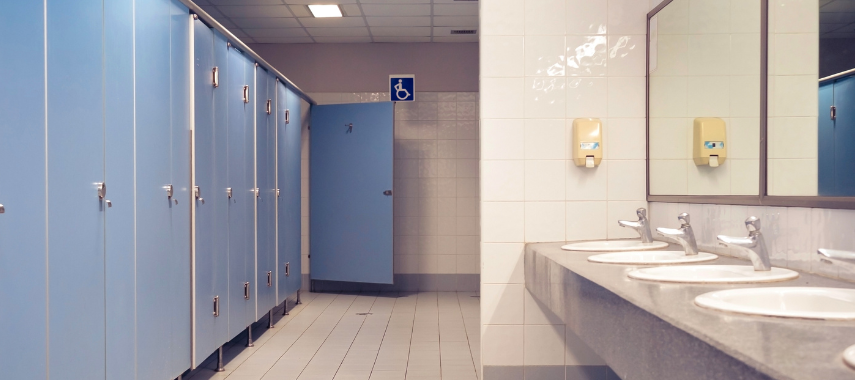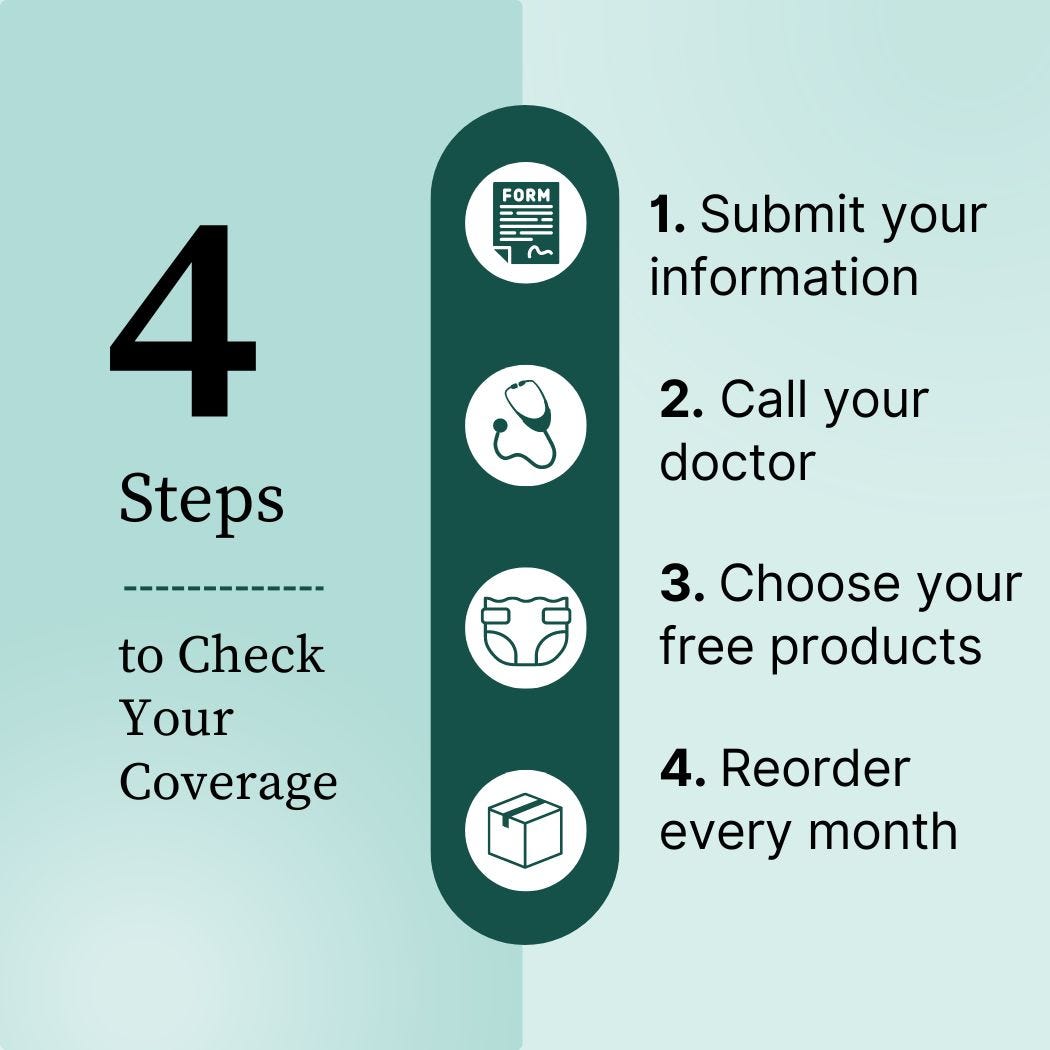Key Takeaways:
-
Accessible restrooms help those with disabilities and incontinence maintain their dignity and safety.
-
Inaccessible bathrooms come with barriers, reinforcing social isolation for people living with disabilities.
-
Advocating for accessible restrooms that have widened hallways, adult-sized changing tables, and more, can help everyone use public bathrooms safely and confidently.
Check Your Eligibility
2 Easy Steps
Discover the continence care essentials available through your Medicaid plan.
For people living with incontinence and disabilities, navigating a world where accessible restrooms are often an afterthought is a constant battle. This lack of access and a lack of understanding and compassion creates a feeling of exclusion.
To change this, we need to expose the injustices caused by inaccessible restrooms. These spaces can be unsafe, denying individuals basic dignity and making it difficult to maintain hygiene. This lack of access sends a clear message of disrespect and neglect toward individuals with disabilities and their caregivers. Ultimately, it prevents full participation in community life, leading to social isolation and impacting overall well-being.
Understanding the Need for Accessible Restrooms
Effective awareness leads to public education and a well-informed general public. It all begins with the realization that to enact change and bring about inclusion and accessibility (of any kind), as well as acceptance, it must start with spreading more awareness.
You can't change issues and bring about more inclusion and accessibility if there is no actual recognition and acknowledgment that ongoing problems require solutions.
It bears mentioning the basic fact that if you have never been close to someone experiencing a disability and the lack of access and accommodations out in the real world, you may be totally unaware of the real-life issues and barriers that they encounter daily, even today.
If you're not experiencing it, you may take many things for granted in your own "typical" life, such as using any public bathroom easily or entering any building with a staircase or steps outside without any problem.
Therefore, we urge you to look at the issues from an empathetic and compassionate standpoint and begin by considering the following key points:
- The fact is that there is a real need for accessibility and inclusion, as the world is not fully accessible and equitable to everyone (yet).
- It all begins with spreading awareness so that there's greater public education and a push to become part of a movement for change. It continues by advocating persistently for disability rights, positive change, and actual action.
- Accepting the reality that increased accessibility benefits all of us as this leads to a greater sense of autonomy, independence, productivity, improved health, and improved lifestyles for those living with incontinence and a disability.
- Accepting that achieving a more inclusive and accessible world is a journey that will take time, with perhaps many small steps of progress taking place over the years.
- Accepting the fact that this change will take massive efforts from many people who possess diverse skills but share common goals. One person's voice can be powerful and create a movement, but it takes the efforts of many to enact more meaningful change.
Check your coverage for 100% free incontinence products now!
Check your coverage for 100% free incontinence products now!
The Role of Caregivers in Accessible Restrooms
Caregivers play a vital role in helping people with disabilities, often working tirelessly to meet their needs and ensure their inclusion in the community. When accessible restrooms are lacking, caregivers face additional burdens in maintaining their loved ones' hygiene and dignity. Caregivers need support from society in advocating for and creating more accessible spaces.
Caregiving families are, generally speaking, very capable, devoted, and concerned families who are on extensive and exhaustive journeys, in terms of working around the clock to best meet the ongoing needs of their loved ones with disabilities. They are the real experts in knowing their loved ones best, as there's no substitute for this specific experience.
Many strive to offer their loved ones as full a life as possible, dedicated to providing their families the best quality of life and more positive outcomes. When caregivers plan and venture out into their communities with their loved ones whenever possible, they ensure their loved ones are included, well-cared for, and happy.
They are always mindful of finding ways to make outings more manageable, enjoyable, and enriching for their disabled loved ones and their families so that they can repeat these experiences and create good memories, just like any other family does!
Caregiving families are also always working towards meaningful progress no matter how small, and as such, they need society to step up and provide more support and tangible progress.
Challenges & Solutions for Inaccessible Restrooms
Temporary Solutions
The lack of accessible restrooms that meet ADA standards often forces people to resort to temporary and frequently undignified solutions. These include:
- Bring extra supplies with you in public. Bring extra clothing, towels, change mats, etc., so as not to lie down on a filthy or wet floor space in a public restroom when needing to change a diaper or pull-up. This is an option that is appalling, unsanitary, and disrespectful to both the person with disabilities and their caregiver, one which is a last resort option under desperate circumstances.
- Stay home. Stay home and avoid community participation and opportunities for inclusion, solely because no suitable fully-accessible washrooms are available at the family fair, theme park, restaurant, sports arena, mall, etc. These are very disappointing realities for a caregiving family who wishes to attempt and enjoy outings together. It's sometimes easier to stay home, and it's essential to recognize that this is a reality for many people living with disability and incontinence.
- Use privacy measures. Resort to privacy measures involving family members working together to provide makeshift privacy screens with large bath sheets, bedsheets, or blankets in a secluded area behind trees, etc., within a public park or beach to change their loved one with an incontinence issue.
- Making a privacy tent. These privacy screens attach to the rear inside panels of a minivan and wrap around the open trunk, facilitating a private zone in order to ensure the changing process is out of sight from onlookers. I am sure many of us are familiar with lying down our loved ones on towels or blankets in an open trunk space to change their diaper, etc. This is far from ideal, for so many good reasons.
- Change in a bathroom stall. Some families may feel that they have no other choice but to try and change their child on a baby change table in a public washroom stall. Please note that safety is vital above all else and that many change tables are typically only designed for babies and toddlers weighing up to 30 or 35 lbs. in many cases. The risk of serious injury to a child or their caregiver is elevated when equipment not designed for older toddlers and children is misused. Please refrain from this option based on your circumstances, and never use unsuitable and unsafe equipment.
Long-Term Solutions
To create lasting change, we need effective advocacy. With their lived experience, caregivers are uniquely positioned to advocate for accessible restrooms that are ADA compliant. They can use social media, connect with non-profit organizations, write to politicians and companies, and educate themselves on accessibility laws.
- Harness the power and reach of social media. Use the power of social media as much as you can to spread the word. Sharing on social media doesn't cost a dime either; it can be done quickly from the comfort of your home. With the appropriate numbers, increase in followers, and hashtags, spreading awareness on the issues that matter becomes more straightforward and more manageable for many of us.
- Find those non-profit organizations and other opportunities to strive for more favorable outcomes, a better quality of life, and a level playing field for our loved ones. Join a non-profit or consider volunteering your time.
- Write to your local politician outlining the issues, while offering the possible solutions and benefits for disabled individuals and the community.
- Write to the companies you feel need to make more changes to provide more accessible and better-equipped public washrooms.
- Support the companies in ways that make sense for your own family situation that are already excelling at providing fully accessible measures for disabled and incontinent people. Choose wisely in terms of where you will spend your money and time.
- Know your rights and the laws on accessibility in your area. Also, familiarize yourself with the "grey" areas of these laws. This means that in much older, protected public buildings, full accessibility may not be an option for every establishment. This may be due to the exorbitant costs and extensive necessary alterations that may be deemed unrealistic for a small business to undertake, for example. Understand that there are always exceptions and legal exclusions.
What Does Accessible Restrooms Look Like?
Why do accessible public washrooms and additional features such as universal change tables (or adult-sized change tables) actually matter?
In a nutshell, disability rights are human rights. As such, all human beings deserve the right to experience sanitary, safe, private, dignified, and user-friendly public washrooms that can accommodate their disability support needs and the needs of their supporting caregivers. Safety, dignity, and privacy are paramount for all of us when we use any washroom facility in public.
When we need to use the bathroom, we need to be able to access it, which goes beyond basic wheelchair access. A forward approach to creating an ADA-compliant bathroom also includes:
- Widened hallways.
- Enough room in the bathroom for all mobility devices and the additional caregiver.
- Safe privacy door lock buttons.
- Adult-sized changing tables.
- Safety emergency cords that are reachable from floor level.
- Grab bars for support.
- A lowered accessible toilet with a lower toilet seat.
- Lower sinks, faucets, and soap dispensers with room for mobility devices.
- Power adjustable universal change tables.
- Lower toilet paper dispensers.
- Lower paper towel dispensers.
- Push button, power-operated restroom doors, ideally ones that open outwards (if clearance allows), for extra maneuverability room.
- Low flushers, which are more easily reachable or flushers with automatic sensors.
- Easy-to-operate, single-lever mixer faucets which help ensure safer water temperatures, or faucets with automatic sensors.
- In public restrooms equipped with automatic hand dryers, always offer sufficient paper towels as an alternative in order to accommodate the needs of those with sensory processing differences, especially those with sensitivity to loud sounds.
This is all in addition to the cleanliness, regular inspections, and maintenance of all washroom spaces.
Accessibility that is well-planned, flexible, open-ended, diverse, and customizable is the only way to ensure the safety of those with disabilities and other life-altering conditions, as well as those who are aging and may live with vision loss, less mobility, or some other condition requiring higher-support needs.
We need accessibility to be able to meet the demands of a multitude of diverse needs, as disability and incontinence encompass many different needs and medical conditions in an ever-increasing percentage of the general population.
Changing a pull-up, diaper, etc., safely, hygienically, and privately, or using an accessible washroom more independently (or with assistance) is about meeting basic essential needs. This allows many individuals with disabilities and their families to access their communities more fully. In summary, it's about achieving a better quality of life, not to mention embracing more inclusion in action.
The Benefits of Accessible Restrooms
Accessible restrooms provide numerous benefits, including:
- Promote dignity.
- Promote independence.
- Facilitate inclusion and participation in community life.
- Improve physical and mental health.
- Contribute to economic benefits for businesses and communities.
Conclusion
Accessible restrooms are not a luxury; they are a fundamental human right. Ensuring everyone has access to safe, dignified, and inclusive restroom facilities is essential for creating a truly equitable society. Let's continue to advocate for change, raise awareness, and work towards a world where accessible restrooms are the norm, not the exception.
Disclaimer
Information provided on the Aeroflow Urology blog is not intended as a substitute for medical advice or care from a healthcare professional. Aeroflow recommends consulting your healthcare provider if you are experiencing medical issues relating to incontinence.












